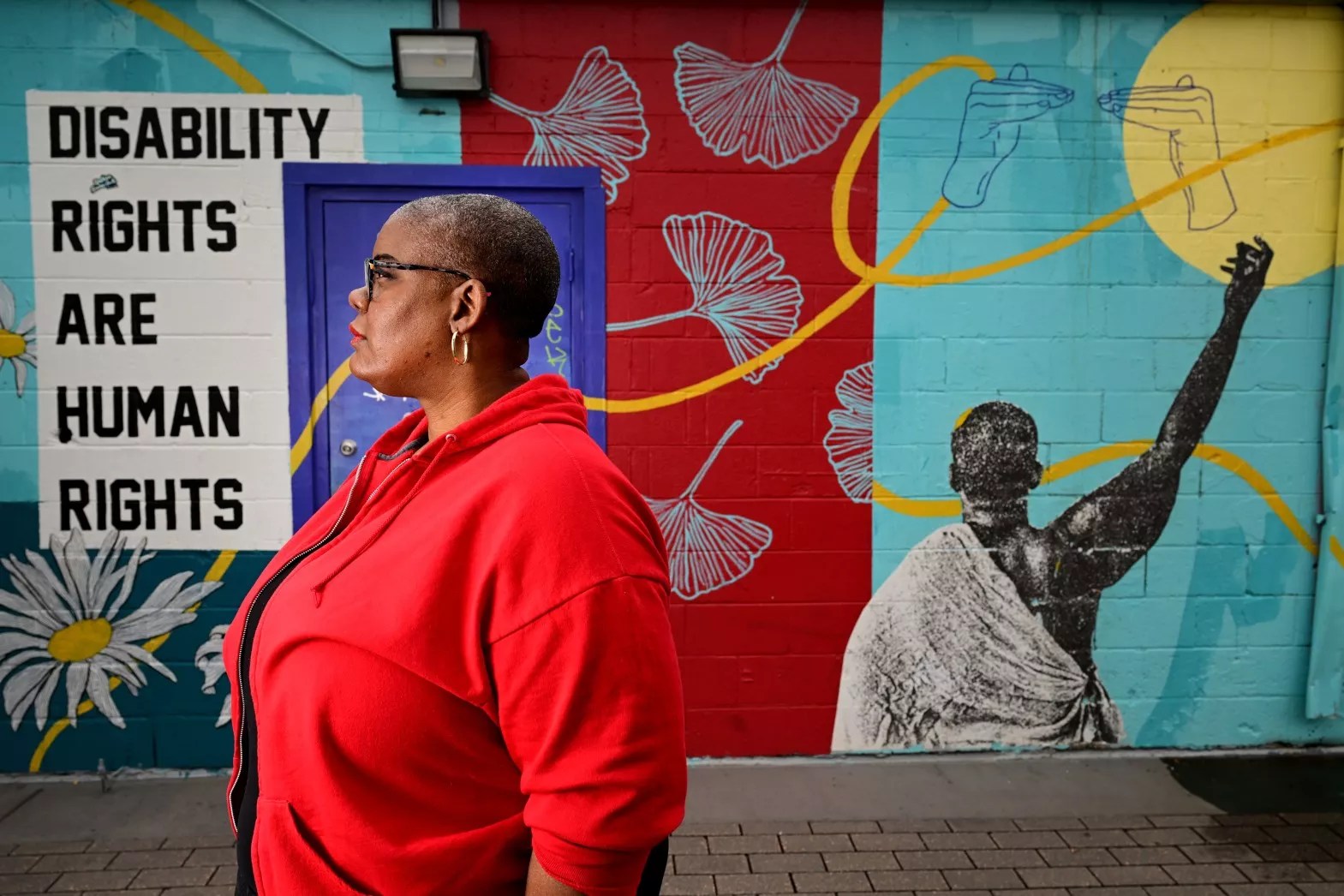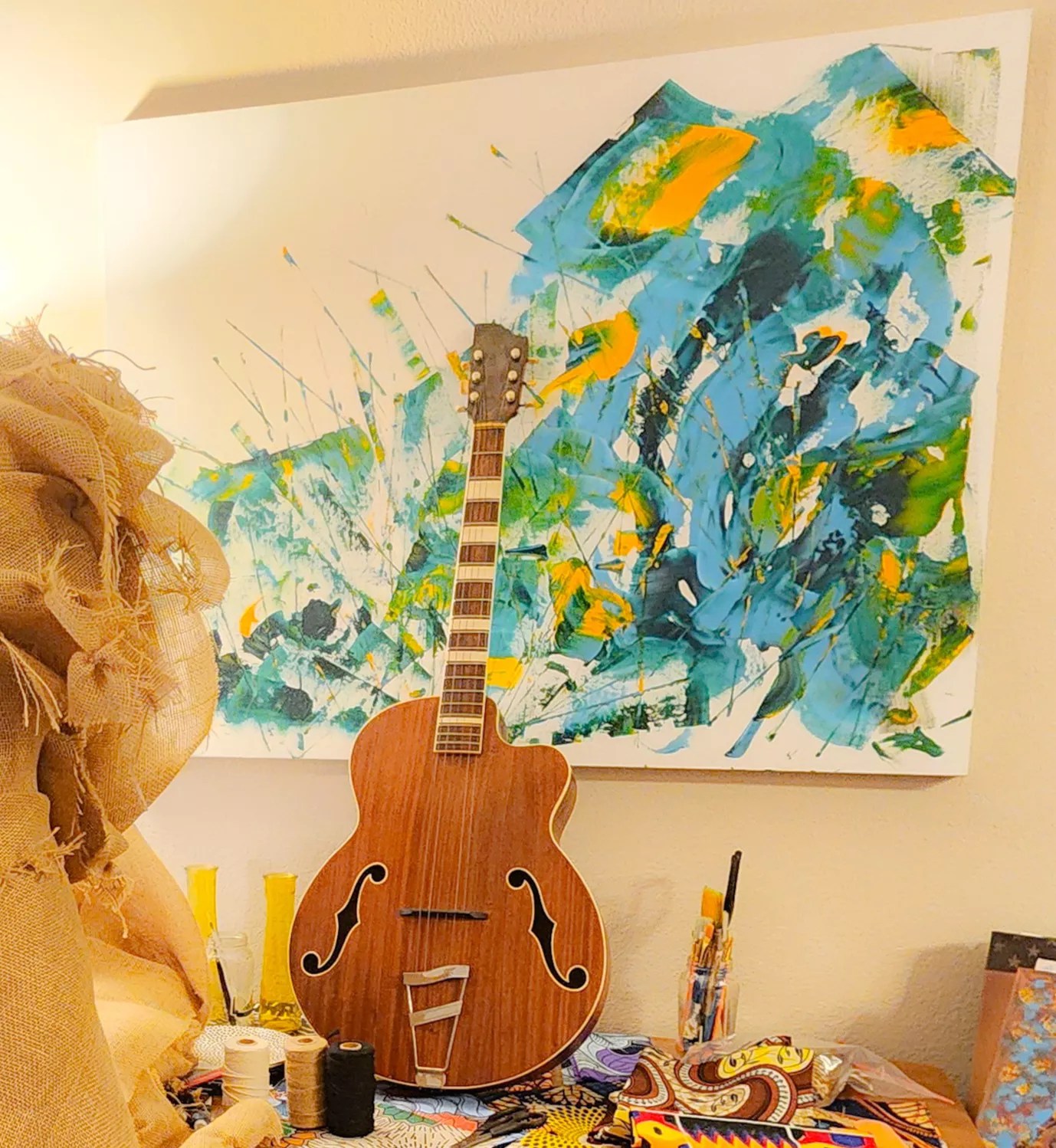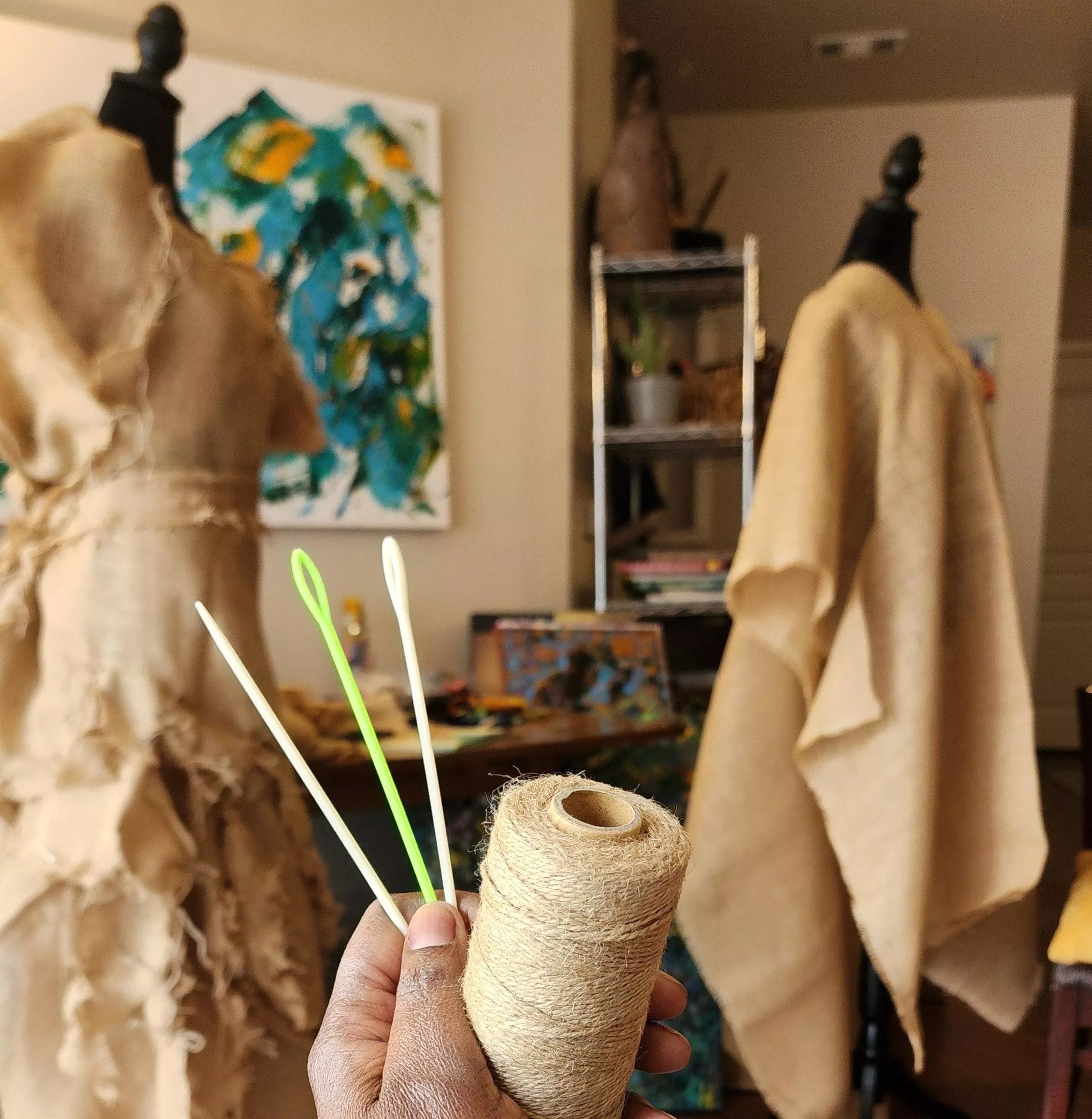
Courtesy of Helen H. Richardson

Audio By Carbonatix
Sitting in her new studio space in Ironton Distillery & Crafthouse, Chloé Duplessis is surrounded by her latest creations for an installation about the legendary gospel singer-songwriter Sister Rosetta Tharpe. With a resolute expression, the legally blind artist and historian reflects on the life-changing diagnosis she received in 2019.
“My practice is called Duplessis Art,” she begins. “We create art and immersive cultural experiences anchored by the importance of accessibility and history. Accessibility because I am legally blind. I have Stargardt disease, a rare form of macular degeneration that is genetic. I am down to about 40 percent vision now, and it is happening gradually. As a creator, particularly one who works in the visual arts, this presented a unique opportunity to serve.”
Diagnosed just two weeks before she and her husband were planning to move to Colorado from her home state of Louisiana, she faced a stark choice.
“You can either sit until the curtain closes, or you can show up every day,” Duplessis says. “The one thing the doctors couldn’t tell me was when I would lose my vision. I prayed about it, and I spoke with my husband, Shaun, who is an incredible source of support and encouragement. I had worked for others for nearly twenty years and knew what that experience was like, but I realized that if I did not start centering my own art, I would never know what that path looked like. So we decided to keep moving to Denver, and I started showing up every day as if it were the last day I’d see.”
Will you step up to support Westword this year?
At Westword, we’re small and scrappy — and we make the most of every dollar from our supporters. Right now, we’re $23,000 away from reaching our December 31 goal of $50,000. If you’ve ever learned something new, stayed informed, or felt more connected because of Westword, now’s the time to give back.

Chloé Duplessis, a legally blind artist, is “very mindful of the timetable I am working on.”
Courtesy of Helen H. Richardson
Duplessis had always valued accessibility even before she began losing her vision, so she feels that “on many levels, I was prepared for this work.” She is also a historian by trade, having worked in government, higher education and in the community conducting oral-history interviews. “History is always at the very center of the practice – literally, the center of my practice,” she says.
The artist’s personal biography is steeped in history, too. Her grandfather, the late Dr. E. Edward Jones, was one of the first Black political officeholders in Louisiana. He and Duplessis’s grandmother, along with several other concerned citizens, filed the lawsuit that led to the desegregation of Caddo Parish in Shreveport. When she was five years old, her mother was “our region’s Ruby Bridges” and helped integrate the school system at Creswell Elementary in Shreveport.
“I come from a family of history makers,” Duplessis explains. “When I think about being born into this work, I am not going to take credit for their sacrifice or intention, but I hope to extend their legacy and impact through my art.”

A finished piece from Sister Rosetta.
Courtesy of Chloé Duplessis
Since moving to Denver, Duplessis has accomplished a remarkable amount. She created Denver’s first accessible “I VOTED” sticker, which incorporated a high-visibility color scheme, braille and ASL. She also co-created the “Holding Hope” mural in the EDENS alley at Denver Central Market in RiNo, which raises visibility for Denver’s disability community. Her dedication and impactful work were recognized by the 2023 Denver Mayor’s Award for Excellence in Arts and Culture in Equity, Diversity, and Inclusion.
She is currently channeling her rich heritage into her latest project, Sister Rosetta, an art installation that celebrates the life and musical legacy of rock-and-roll pioneer Sister Rosetta Tharpe. The exhibit, set to open at the Blair-Caldwell African American Research Library on Saturday, June 1, honors Tharpe’s contributions to music history.
“I had heard her name all my life, but I didn’t make the connection about her significance until about four years ago,” Duplessis says of the musician. “I heard a friend who was a music historian talking about the Baz Luhrmann Elvis film they were making and that Elvis was inspired by not one, but two Black women. I knew about Big Mama Thornton, but then I wondered, ‘Who is the other woman?’ When I dug deeper, I realized it was Sister Rosetta Tharpe, and Elvis didn’t just take a song; he adopted her style.”

Sister Rosetta Tharpe was known as the Godmother of Rock and Roll.
Courtesy of Chloé Duplessis
Known as the “Godmother of Rock and Roll,” Tharpe was a trailblazer whose innovative guitar playing and powerful voice influenced some of the biggest names in rock and roll, including Chuck Berry, Elvis Presley and Johnny Cash. She blended gospel with rhythm and blues, creating a sound that was ahead of its time and paved the way for future generations of musicians.
After the release of Elvis in 2022 and her inclusion in the film, Duplessis kept hearing Sister Rosetta’s name mentioned. Even though she did not have a venue lined up, Duplessis “knew there was a show there,” but she put the idea aside to focus on other projects.
The chance to actualize the installation took shape after Duplessis completed her residency in Trinidad at the East Street School and returned to Denver. At an exhibition at the Blair-Caldwell African American Research Library celebrating Black History Month early this year, Duplessis ran into Dexter Nelson II, the library’s curator, who invited her to have a meeting about doing an installation for the venue.
“After hearing Dexter’s ideas, I said, ‘That is great, but we are in Five Points; it’s the ‘Harlem of the West.’ If you are open to it, I have an idea for an extraordinary show, and I believe this is the right venue.’ He seemed interested, so I pitched him my idea for a show about Rosetta Tharpe,” Duplessis says. “I then said, ‘If you will let me, I would like to honor this extraordinary woman in June because it is Black Music Month and she is an American music pioneer that more people should know.’ They took a moment, turned around and said yes. That was around two and a half months ago.”

“Because of my vision loss, I am no longer able to sew with a needle and thread, but I can sew with twine,” says artist Chloé Duplessis.
Courtesy of Chloé Duplessis
With the green light from the library, Duplessis began planning the exhibit’s vision and layout. The installation includes an Afrofuturist dress inspired by Tharpe’s iconic performance garments, surrounded by a garden made from actual records by Tharpe and her contemporaries.
“We are seeking to show these are the roots from which so much music comes,” Duplessis says. “Each piece is hand-made. Because of my vision loss, I am no longer able to sew with a needle and thread, but I can sew with twine. Twine is used consistently in my work because it is a grounding fiber; it is very resilient and represents our beautiful Indigenous community and people of color. Part of the dress is frayed to honor the fact that her leg was amputated in her later years. I was already in love with her, but when I discovered that she was dealing with disability and was back on stage rocking out six months later, I wanted to honor that in the work, as well.”
A timeline of Tharpe’s life will be displayed on the walls, drawn from Gail Wald’s book Shout, Sister, Shout! and research conducted by Wald and her collaborator, musician and educator Joe Mazza; there are also artifacts, such as a World War II guitar.
“There are so many chapters in her life,” Duplessis says. “We encourage people to conduct their own research and revel in extraordinary humans because there is only so much you can present in an installation. Hopefully, this will encourage people to do their own research and learn more about Sister Rosetta Tharpe.”

A finished piece from Sister Rosetta.
Courtesy of Chloé Duplessis
Duplessis and Mazza have planned a series of events to engage the community. The library will host an opening reception on Saturday, June 1, from 2 to 4 p.m. In conjunction with the Five Points Jazz Festival, they will hold a pop-up recording session on June 8 from 11 a.m. to 1 p.m., where participants can sing along to tracks Mazza is creating in the style of Tharpe’s spirituals.
“It’s a really cool way to reimagine oral history,” Duplessis says. “Through these additional events that we’re doing, people can lend their voice to the story. It’s no longer just a presentation; you’re a part of the art.”
On June 25, the collaborators will give an educational lecture from 5:30 to 7 p.m., with Duplessis focusing on Tharpe’s cultural impact, and Mazza, who has been playing guitar for decades, discussing her musical influence. Both Duplessis and Mazza are exploring ways to make the exhibit’s closing on August 31 as memorable as its opening.
“We want to have a closing reception that turns into basically just a big jam session, because who doesn’t love that energy?” Duplessis says with a smile. “But as much as I am a planner, the energy with which the show opens will influence what we do, because we are here to serve – we want it to be fitting of her legacy.”
“Bringing her story back to Five Points, where she performed at East High 77 years ago, feels right,” she concludes. “We want people to leave inspired by her extraordinary life and legacy. I am very mindful of the timetable I’m working on. Not just as a person of color in their forties, but because of my vision. I know that in my heart of hearts, I will always be a creator, but what that looks like will change – because it has to change.”
Sister Rosetta, Saturday, June 1, through August 31, Blair-Caldwell African American Research Library, 2401 Welton Street. Learn more at history.denverlibrary.org/blair.